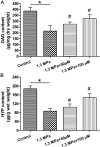Resveratrol increases nucleus pulposus matrix synthesis through activating the PI3K/Akt signaling pathway under mechanical compression in a disc organ culture
- PMID: 29074559
- PMCID: PMC5700294
- DOI: 10.1042/BSR20171319
Resveratrol increases nucleus pulposus matrix synthesis through activating the PI3K/Akt signaling pathway under mechanical compression in a disc organ culture
Retraction in
-
Retraction: Resveratrol increases nucleus pulposus matrix synthesis through activating the PI3K/Akt signaling pathway under mechanical compression in a disc organ culture.Biosci Rep. 2024 Aug 28;44(8):BSR-2017-1319_RET. doi: 10.1042/BSR-2017-1319_RET. Biosci Rep. 2024. PMID: 39171804 Free PMC article. No abstract available.
Abstract
Disc nucleus pulposus (NP) matrix homeostasis is important for normal disc function. Mechanical overloading seriously decreases matrix synthesis and increases matrix degradation. The present study aims to investigate the effects of resveratrol on disc NP matrix homeostasis under a relatively high-magnitude mechanical compression and the potential mechanism underlying this process. Porcine discs were perfusion-cultured and subjected to a relatively high-magnitude mechanical compression (1.3 MPa at a frequency of 1.0 Hz for 2 h once per day) for 7 days in a mechanically active bioreactor. The non-compressed discs were used as controls. Resveratrol was added along with culture medium to observe the effects of resveratrol on NP matrix synthesis under mechanical load respectively. NP matrix synthesis was evaluated by histology, biochemical content (glycosaminoglycan (GAG) and hydroxyproline (HYP)), and expression of matrix macromolecules (aggrecan and collagen II). Results showed that this high-magnitude mechanical compression significantly decreased NP matrix content, indicated by the decreased staining intensity of Alcian Blue and biochemical content (GAG and HYP), and the down-regulated expression of NP matrix macromolecules (aggrecan and collagen II). Further analysis indicated that resveratrol partly stimulated NP matrix synthesis and increased activity of the PI3K/Akt pathway in a dose-dependent manner under mechanical compression. Together, resveratrol is beneficial for disc NP matrix synthesis under mechanical overloading, and the activation of the PI3K/Akt pathway may participate in this regulatory process. Resveratrol may be promising to regenerate mechanical overloading-induced disc degeneration.
Keywords: matrix; mechanical compression; nucleus pulposus; resveratrol.
© 2017 The Author(s).
Conflict of interest statement
The authors declare that there are no competing interests associated with the manuscript.
Figures





Similar articles
-
Resveratrol attenuates mechanical compression-induced nucleus pulposus cell apoptosis through regulating the ERK1/2 signaling pathway in a disc organ culture.Biosci Rep. 2018 Mar 9;38(2):BSR20171703. doi: 10.1042/BSR20171703. Print 2018 Apr 27. Biosci Rep. 2018. Retraction in: Biosci Rep. 2024 Aug 28;44(8):BSR-2017-1703_RET. doi: 10.1042/BSR-2017-1703_RET. PMID: 29439139 Free PMC article. Retracted.
-
Resveratrol enhances matrix biosynthesis of nucleus pulposus cells through activating autophagy via the PI3K/Akt pathway under oxidative damage.Biosci Rep. 2018 Jul 6;38(4):BSR20180544. doi: 10.1042/BSR20180544. Print 2018 Aug 31. Biosci Rep. 2018. Retraction in: Biosci Rep. 2024 Aug 28;44(8):BSR-2018-0544_RET. doi: 10.1042/BSR-2018-0544_RET. PMID: 29752339 Free PMC article. Retracted.
-
Dynamic Compression Promotes the Matrix Synthesis of Nucleus Pulposus Cells Through Up-Regulating N-CDH Expression in a Perfusion Bioreactor Culture.Cell Physiol Biochem. 2018;46(2):482-491. doi: 10.1159/000488616. Epub 2018 Mar 26. Cell Physiol Biochem. 2018. PMID: 29614512
-
Dynamic Compression Effects on Immature Nucleus Pulposus: a Study Using a Novel Intelligent and Mechanically Active Bioreactor.Int J Med Sci. 2016 Feb 20;13(3):225-34. doi: 10.7150/ijms.13747. eCollection 2016. Int J Med Sci. 2016. PMID: 26941583 Free PMC article.
-
Long-term load duration induces N-cadherin down-regulation and loss of cell phenotype of nucleus pulposus cells in a disc bioreactor culture.Biosci Rep. 2017 Apr 28;37(2):BSR20160582. doi: 10.1042/BSR20160582. Print 2017 Apr 30. Biosci Rep. 2017. Retraction in: Biosci Rep. 2024 Aug 28;44(8):BSR-2016-0582_RET. doi: 10.1042/BSR-2016-0582_RET. PMID: 28351894 Free PMC article. Retracted.
Cited by
-
Transducing compressive forces into cellular outputs in cancer and beyond.Life Sci Alliance. 2023 Jun 26;6(9):e202201862. doi: 10.26508/lsa.202201862. Print 2023 Sep. Life Sci Alliance. 2023. PMID: 37364915 Free PMC article. Review.
-
Low Magnitude of Compression Enhances Biosynthesis of Mesenchymal Stem Cells towards Nucleus Pulposus Cells via the TRPV4-Dependent Pathway.Stem Cells Int. 2018 Apr 17;2018:7061898. doi: 10.1155/2018/7061898. eCollection 2018. Stem Cells Int. 2018. PMID: 29765419 Free PMC article.
-
Disease-associated regulation of gene expression by resveratrol: Special focus on the PI3K/AKT signaling pathway.Cancer Cell Int. 2022 Sep 30;22(1):298. doi: 10.1186/s12935-022-02719-3. Cancer Cell Int. 2022. PMID: 36180892 Free PMC article. Review.
-
miR-19a mitigates hypoxia/reoxygenation-induced injury by depressing CCL20 and inactivating MAPK pathway in human embryonic cardiomyocytes.Biotechnol Lett. 2021 Feb;43(2):393-405. doi: 10.1007/s10529-020-03045-2. Epub 2020 Nov 9. Biotechnol Lett. 2021. PMID: 33165673
-
Pharmacological Effects of Resveratrol in Intervertebral Disc Degeneration: A Literature Review.Orthop Surg. 2022 Dec;14(12):3141-3149. doi: 10.1111/os.13560. Epub 2022 Oct 27. Orthop Surg. 2022. PMID: 36303427 Free PMC article. Review.
References
-
- Borenstein D. (1991) Low back pain: epidemiology, etiology, diagnostic evaluation, and therapy. Curr. Opin. Rheumatol. 3, 207–217 - PubMed
-
- Manchikanti L., Singh V., Falco F.J., Benyamin R.M. and Hirsch J.A. (2014) Epidemiology of low back pain in adults. Neuromodulation: J. Int. Neuromodulation Soc. 17, 3–10 - PubMed
-
- Roberts S. (2002) Disc morphology in health and disease. Biochem. Soc. Trans. 30, 864–869 - PubMed
Publication types
MeSH terms
Substances
LinkOut - more resources
Full Text Sources
Other Literature Sources
Miscellaneous

